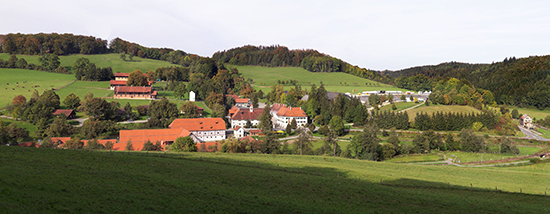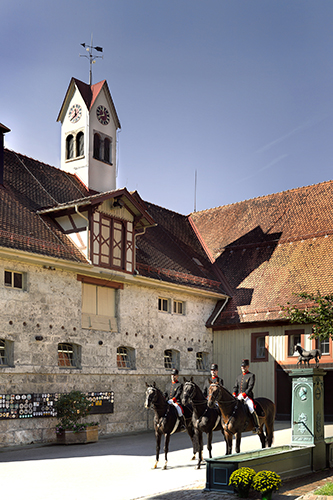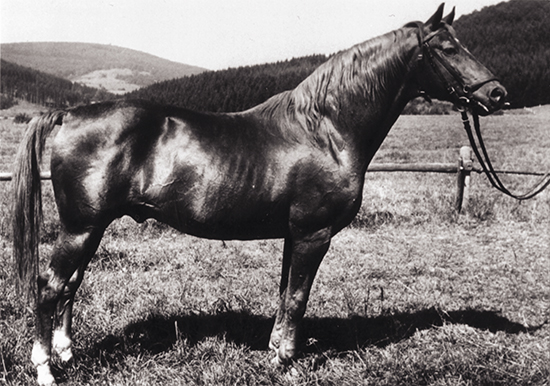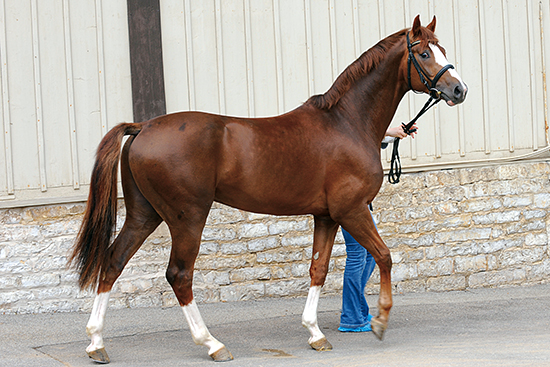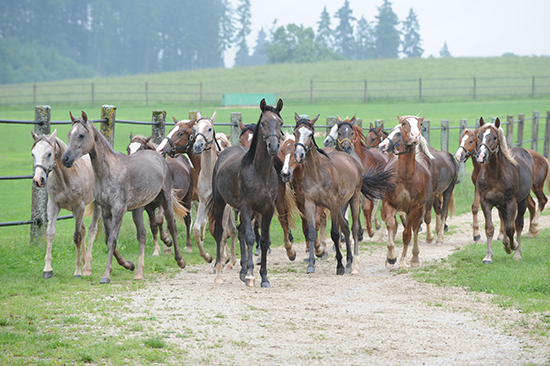 Story by Chris Hector & Photos by Roz Neave
Story by Chris Hector & Photos by Roz Neave
Dr Astrid von Velsen-Zerweck is one of the new young dynamic group of stud leaders who have emerged with the changing-of-the-guard over the last few years to assume the leadership of Germany’s famous state studs. The challenge she faces is daunting…
The Marbach stud is not only one of the biggest – 1000 hectares – but it is also the oldest in Germany going back to the middle ages, when Graf Eberhard V established his own private stud between 1477 and 1480. The ruling Dukes soon realized the need to improve the quality of the local horse breeds, and in 1573 Marbach was elevated to the status of a court and state stud.
The 18th and 19th centuries saw the introduction of Mecklenburger, Holstein, English half-breeds, and Norman-bred horses, to improve the quality of the local working horses. Heavier types, such as the Cleveland Bay, Yorkshire Coach Horse and Clydesdale were also used to improve substance and bone.
From about 1896 to 1950 breeding was concentrated on the Württemberger horse, an all-rounder suitable for agriculture and saddle. From the mid-1950’s it was decided to attempt to breed a lighter, more athletic, modern riding horse. The Trakehner stallion Julmond was used as the foundation stallion, and despite being 22 years old when he arrived at Marbach, he helped establish the modern Württemberger Warmblood. Blood from Hannover, Oldenburg and Holstein, as well as Trakehner and English Thoroughbred stallions, has refined the breed more recently, producing today’s Württemberger who looks – as is the case in all the modern studbooks – just like all the other modern German Warmblood horses…
Marbach is also well known as the home of Europe’s oldest Arab herd, the Weil-Marbach Arabians. Between 1814 and 1819 King Wilhelm I of Württemberg imported a number of Arabian stallions and mares from the Middle East and established his own private stud at Weil (Esslingen). When he died in 1864 these Arabians were considered to be the best in Europe. However, the stud went into decline between 1890 and 1932, and at the height of economic and financial crisis in 1932, Princess Pauline zu Wied decided to sign the entire breeding stock over to Marbach, as the last will and testament of King Wilhelm I forbade the disbandment of the herd.
The post-war years saw the Weil-Marbach Arabians at another low-point – the original 17 horses to come from Weil in 1932 carried only one bloodline and another out-cross was urgently required. Salvation came in the form of a desert-bred stallion, Hadban Enzahi, imported from the El Zaraah stud in Egypt in 1955 as a three-year old. Such was his influence on the Weil-Marbach Arabians that his legacy can still be seen today in some of the resident Arabian stallions, mares and foals at Marbach. More recently, the Marbach Arabian mares have been covered by Inshallah – a stallion dedicated by Her Royal Highness, Princess Alia of Jordan, the sister of the FEI President, Princess Haya.
Despite the challenge that she faces, Astrid looks remarkably relaxed, and laughs a lot. Nonetheless, she is well aware of the responsibility that rests on her shoulders:
“Marbach is a very old stud with almost 500 years of history. We have not only been breeding Warmbloods and also Arabs, we are also involved in a breeding program for local horse breeds that are threatened – like the Schwarzwälder Kaltblüter (the Black Forest cold blood) and the heavy Warmblood, the Altwürttemberger. Marbach owns about 300 horses, and 200 horses are raised for breeders.”
Is it a juggling act between preserving the legacy of a very old stud, and respecting the genetic heritage of the horses – but at the same time you want to be at the Bundeschampionate… winning?
“Yes, it is difficult to do both jobs. Mainly we raise and ride young horses, and we run a ‘Hengstleistungsprüfungsstation’ (stallion testing station) so we are very good at training colts for the stallion tests, mares for the mare tests, and cold bloods for the cold blood tests. We have quite a lot of good riders for young horses but not so many for showing horses at the higher levels. We’re trying to build that up, so we can both train the young horses and have specialised competition horses in dressage and showjumping, maybe endurance with the Arabs…”
But Marbach is not ranked with the really big studbooks, like Holstein and Hanover?
“Horse breeding in Germany is mainly concentrated in the north. In the southern parts of Germany, the tendency was to breed with the genetic material from the north. Today, the quality of the Württemberger horses is closing up to national and international level. There are quite good riders in Southern Germany, the horse sport is carried out on a high level.”
The founding father, the Trakehner, Julmond
Recently you have moved strongly in two directions – with some French blood for the jumping breeders and some cutting-edge bloodlines for the dressage breeders… do you think you will develop two separate breeding streams?
“Yes, that was already happening before I came. The older stallions are more all-rounders and the younger ones are more specialists. But nevertheless I think a good dressage horse should be able to jump a few fences without ‘breaking a leg’, and it should have a good back to be strong and in balance. On the other hand, jumping horses should have good gaits and a good rideability too. Breeders always aim at breeding top horses. Only a very small percentage make it to the top, 95% are ‘normal’ horses. These should have good gaits, they should be healthy and with a good character and temperament so that the normal rider can handle them.”
One of the exciting young dressage stallions at Marbach, Sir Nymphenburg – by Sir Donnerhall
Marbach is one of the leaders in the modern trend of a public-private partnership – with state studs standing stallions in partnership with prominent private owners. Thus Celle has gone in partnership with Xavier Marie of the Haras du Hus, to stand the Hanoverian licensing champion, Soliman (Sandro Hit / Donnerhall) at Celle, while another recent licensing champion, Holstein’s Diarado (Diamant de Sémilly / Corrado / Contender) is shared between Germany’s Paul Schockemöhle and Holland’s Joop van Uyert and the Holsteiner Verband.
In the current Marbach stallion line up we find the English Thoroughbred, Chase the Ace (Nashwan xx / Caerleon xx), owned by the Englishwoman, Heather Hyde-Saddington, Clinton I (Carolus I / Calypso II) and Clintord (Clinton I / Caletto I) both owned by Sportferde Ahlmann; C-Indoctro II (Capitol I / Caletto II) owned by the Frenchman, Stéphane de Saligny; Epris d’Azur (Laudanum xx / Almé) owned by the Swiss, Thomas Hänzi; Ferron (For Pleasure / Concerto II), Qué Guapo (Quintero / Capitol I), Amadehaus (Askari / Fier de Lui Z) – all owned by Monsieur Xavier Marie who must be rivalling Paul Schockemöhle as Europe’s premier private stallion owner.
Also standing at Marbach are Carry (Coronado / Roman / Cottage Son xx) and Colorido (Casado / Silvano / Rocco), both owned by the Holsteiner Verband.
One of the private stallions standing at Marbach is Epris d’Azur, a Selle Français stallion, by the great Thoroughbred jumping stallion, Laudanum xx out of an Almé / Mexico mare – this is very fine French blood indeed.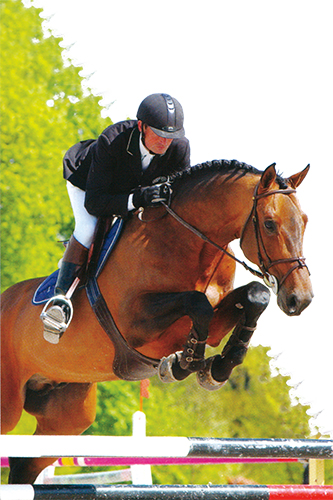
The French stallion, C-Indoctro II, has joined the stallion ranks at Marbach
Was it a risk standing a French jumping stallion?
“No, I don’t think so. Our aim is to offer the breeders new bloodlines to improve the breed. Epris is a horse with a lot of character. He won some showjumping classes with a 14 year old girl and he was shown at an international level by an amateur. And he is a very nice horse in his behaviour with high rideability…”
Marbach also stands the Holsteiner, C-Indoctro II, the younger brother of Indoctro who is based in Holland at the VDL stud. C-Indoctro has until recently stood in France where he was ridden by Eric Navet’s wife.”
Did the breeders send their mares to him?
“He got quite a lot of mares, so did the young French-Holstein horse, Qué Guapo – by Quintero, a grandson of Quidam de Revel out of a Capitol I mare, who belongs to the Frenchman, Xavier Marie. He’s a very good stallion I think – he was one of the best jumpers at the Holstein licensing in 2007 at Neumünster. The breeders like him very much. The combination of Holstein genes and French genes is a very good combination for the jumping breeders.”
Another really exciting stallion is Sir Nymphenburg an explosive mix of the most modern dressage lines – he is by the Bundeschmampion, Sir Donnerhall (Sandro Hit / Donnerhall) out of a Regazzoni (Rubinstein / Werther) Brentano II mare. He is very cute… and he is another owned by a private stallion keeper, in this case, Helmut Freiherr von Fircks, the owner of Munich’s Gestüt Nymphenburg.
Is this the way the state studs must go now to get the top stallions – to go into partnership with the private stallion owners?
“We need to do that because we only have a certain budget for buying horses, which is so small that we can only afford to buy one or two top stallions a year. The other way is to lease stallions… this is what we do with the jumping stallions from Holstein. I think that is a good mix. We need our own stallions too – for all the respresentative duties a state stud has, like Hengstparaden. But the top level horses are so expensive – we need to breed them ourselves, which is a long process, or you can lease them.”
In Hanover the breeders want to use the young stallions, in Holstein the old stallions – what is the preference of your breeders?
“Our breeders like the young stallions. But we have a lot of Holstein friends in southern Germany, especially in Baden-Württemberg who like the older stallions, guys like Cassini and so on. The dressage breeders want the younger ones, the three year old stallions. I remember I was in southern Germany about 12 or 13 years ago with my professor, and we tried to advise the breeders how to make a good breeding program. We were telling them to use a younger stallions in their breeding program to increase breeding progress – which they did – now we have the opposite situation, and I think the breeding associations have to think that through. The young stallions get a lot of mares, which is nice for the stallion owner, but for a breeding program is confused if these stallions are not tested. You only know the exterior, how the horse went at the stallion licensing and the pedigree, the breeding value, and nothing more.”
Your breeders are allowed to use semen from stallions that are not from your studbook?
“Yes. The Württemberg studbook is one of the most liberal studbooks in Germany are far as using ‘foreign’ stallions is concerned.”
While we were visiting Marbach we were privileged to watch a master horseman at work – Fritz Stahlecker is an absolute master of in hand work, and has taken charge of a Marbach project to compare the results of traditional young horse schooling with the Stahlecker method.
It was very nice to watch Mr Stahlecker work with the young horses – in particular the chestnut stallion by Weltpoet…
“That young stallion has developed very nicely and it is very interesting to see how he works with Mr Stahlecker. My parents taught me the classical riding of which they learned from trainers like Paul Stecken, Fritz Tempelmann and Reiner Klimke. I rode and trained young horses in this way. I’m not a rider, but I did that when I was a student at university. I rode in stallion and mare tests, and I found out for myself that the classical way is the best. That is one of the reasons why I was one of the founders of the Xenophon Association. Marbach is one of the ‘banks’ of classical riding and training in Germany. Together with Mr Stahlecker we built up this project working closely with the local university. Two groups of six horses are tested – the traditional Marbach way and the way of Mr Stahlecker. He doesn’t ride the three year old horses but he works them in hand for nine months. He says that young horses want to learn, and they can learn so much in that time that it would be a pity not to do anything with them – they can learn movements in hand.”
Do you think this will be an ongoing part of your program?
“Yes, I think so. What we have done in the past is train the three year olds for three months, and then we have an auction in March and sell them, but that is very early for three year olds. Also lots of our clients are not good enough to ride a three year old. So okay, we raise our horses in groups, why not take these groups and school them for an extra year, with a mixture of the classical way and the Stahlecker method, so they are four year olds when they are sold. They have been ridden in a group outside, also a little jumping over small fences, through water, going in a little hunter class, getting on a lorry… so they have an all-round training. I think there would be a big market for those horses.”
“The best horses, with special abilities for dressage or jumping, we can pick them out and put them with a specialised trainer.”
How important are tourists to your operation?
“The tourists – about 300,000 visit Marbach, Offenhausen and St Johann every year – are very important. It is not only that a state owned stud needs to be transparent for the public – the visitors and guests are also our best clients and promoters who help us to preserve the cultural heritage which we have here with some 180 old buildings.”
That must be an enormous job, just the physical maintenance of the stud?
“Yes, it is, but I like this job because there are so many different things to do. It is not only horse breeding, it is not only stallions, it is not only mares, it is not only agriculture, and not only tourists – it is altogether, and to have this historic dimension is also nice, if you visit the old stud yards, you are aware of all the people and horses living and working here during the past 500 years… that’s really something.”

